Cult and Culture
Every year, The Wall Street Journal features a contest called Winning Workplaces to highlight outstanding small companies. When one reads profiles of the winners, the criteria for selection focus on such things as training, a hands-on work ethic, wellness programs, open book policies and sustainability. Rarely, if ever, is the overall culture addressed.
I suppose the reason is that company culture is hard to define, harder than say that of a sports team or an orchestra where the narrowness of objective tends to attract similar personalities and correspondingly creates cultural constraints. In a company, the diversity of disciplines, from engineering to finance to HR to marketing, attracts a corresponding diversity of personalities. To have a fulfilling environment for this breadth of individuality, the company culture itself must be broadly defined.
We have all heard ad nauseum of companies where “We are family here.” More often than not, that becomes euphemistic for “Your first devotion is to us.” This is not culture but rather, cult, where only those who adhere to the tribal ethic will thrive and prosper. Cult most often orbits about a patriarchal star—less matriarchal as women tend to subsume ego better—or a military work ethic.
Organizations that revolve around cult are more susceptible to ethical breaches as blind loyalty becomes a surrogate for a charter of principles as a foundation. There is also usually a revolving door of employment as whatever might be defined as culture most resembles junior high where one is either in or not and, if not, relegated to insignificance in the company.
Culture, on the other hand, a priori must be inclusive. While hierarchy is necessary to the management of an organization, that verticality must be complemented by the horizontality of culture. While perhaps not as whimsical as a cult-driven organization, one that defaults to chain of command is equally stultifying. An effective culture is, in many ways, independent of a management hierarchy. It is a set of tacitly understood principles—strategic, ethical, social, philosophical—that define the scope of the organization’s activities.
If these principles—different than policies—supersede individual arbitration, the culture not only creates a fulfilling environment for a wide range of people and skills but also instills a climate of self-management where the participants feel committed to uphold the cultural values in exchange for the autonomy conveyed. In a culture that values autonomy, a job description is a skeleton outline of goals and functions but allows creative latitude in how those goals are achieved and functions performed. Autonomous organizations generate far more creativity than those that rely on policy and protocol as people are willing to take initiative and risks in developing new ideas, trying new approaches to old problems or building better mousetraps.
In the largest sense, autonomy fosters a sense of ownership in the overall success of the organization as one feels that her contribution makes a distinguishable difference. More so, if hierarchal management is confined to necessity, the organization is empowered horizontally which cultivates the cross-fertilization of ideas. Finally, if the culture rather than the hierarchy becomes the implicit raison d’être of the organization, ego tends to give way to collaboration.
Just as culture is hard to define, it is elusive to create. Cult and hierarchy are comparatively primitive organisms where culture is the result of evolution—it can’t be created in a day. One thing is clear, however; the seedbed of culture is trust—trust that begins with senior management to empower the whole of the organization. That trust will then grow across the organization and synergies will bloom from there.
But ours goes to eleven- The tenuous role of alcohol in wine
He Said...
- Mike Willison
LADY BRACKNELL- "The chin a little higher, dear. Style largely depends on the way the chin is worn. They are worn very high, at present."
So it is that alcohol in wine is the fashionable thing to be wearing either very high, or just somewhat lower than it is currently. Fashionable wine takes a few seasons to come and go and, just like fashion, can benefit a man to stick with what he knows, provided that what he knows is not parachute pants and Thriller zipper coats. Backlash only happens when someone gets wildly successful doing something that everyone else wishes they had thought of first, or people get genuinely sick of one thing or another. In this case, I believe it to be a combination of both.
Some sommeliers and wine merchants believe that high alcohol wines signify the end of an age of thought provoking, terroir driven wines that were profoundly better matches with food, made only by the most eccentric and affable wine mystics, and consumed in secret dining societies where only the very deserving would be allowed to consume even a drop of the goods. Other sommeliers have no problem lugging a $150, 16.6% alcohol Pinot Noir to the table to be served with your cowboy rib-eye charged ignobly to the corporate card.
What I know is this: delicate varieties become cloying and indistinct when produced in a high alcohol style. Pinot Noir is getting its hand slapped by Syrah for being on its side of the back seat of the car and mom is too busy talking on her mobile to notice so they bicker back and forth until they are all tangled up together and Mom is forced to turn down the radio and pull over. Peppery, inky Pinot Noir? Further, the winemaker that vinifies to high alcohols needs to figure out how to balance the resultant wine now that one of the calipers is in the red. Usually, one will look to longer maceration times, deeper extraction, longer and more aggressive new oak aging and, possibly having to acidify, chaptalize and re-acidify to sort out the mess. Imagine Audrey Hepburn in one of Cyndi Lauper's outfits from the 80's. You’d have to dye her hair, pierce her nose and feed her helium balloons for an hour before she could pull the outfit off. Some varieties just cannot handle the fashion.
She Said...
- Carrie Kalscheuer
Simply because something has always been a certain way doesn't mean that it should be that way. Philosophers call it the "is/ought distinction," and it is one that trips people up regularly. As the success of California Pinot Noir has shown, big, alcoholic, extracted, peppery, inky Pinot Noir is hot. (Please excuse the pun.) So what if Pinot Noir has always been delicate? That’s not necessarily how it always will be – or should be.
Personally, I agree with you about style. I prefer cool climate (and cool vintage) Pinot Noir. I like the tension, the promise. I like to hold on to my Pinot and feel a sense of accomplishment when I open a great, older bottle and am rewarded with a delicate, earthy, balanced wine. Because I want this, I don’t want a high level of alcohol. However, I am not the norm.
95% of all wine is consumed within 4 months of purchase. In this sense, who cares that the alcohol level will be out of balance in 10 years? It’s in balance now and that is what matters to most… now. If right now I’m craving a bone-in rib-eye, a 16.5% abv, peppery, inky Pinot sounds pretty darn good.
Grape berry development
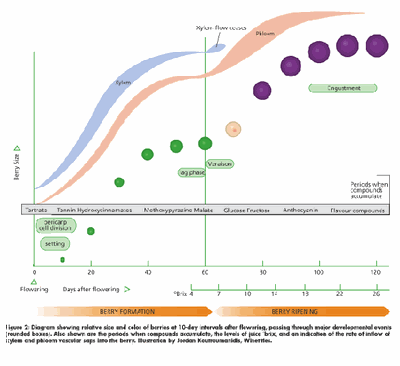
I’m going to give you a brief update on berry development to date here in Oregon.
Currently the North Willamette is coming toward the end of phase 1 in berry development: flowering to lag phase. In the first stage of berry development (phase 1) the berries are growing from cell division. Canopy size, water and nutrient availability influence the amount of carbohydrates available for cell division. Vines with big canopies, lots of water and nutrients will produce large berries with high cell numbers. conversely small canopies and stressed vines will produce small berries with low cell numbers. Equally influential on berry size is seed number. Seeds make auxin and gibberellins (plant hormones) making the berry a stronger sink for assimilates. Lower seed numbers per berry result in less cell division. High numbers of seeds produce greater amounts of hormones stimulating cell division. The final size of the berry is limited by the number of cells in the berry and the extent of expansion and or the degree of shrinkage (from dehydration) in phase 3.
At lag phase, phase 2 of berry development, the size of the cluster is said to be half that at harvest. Growers use this metric to estimate the potential yield of their vineyards and how they are going to crop thin. The problem with this metric is that its very hard to determine exactly when lag phase is without continually measuring berry volume and waiting for it to plateau. Some models suggest lag phase is 55 days after first bloom, other models say its at 1200 GDD (this is measurement of heat units for a growing season) and finally some people go by seed hardening. What am i going to do this year? Seeing that we’ve had seed hardening for over a week and we’re only 45 days post bloom im going to wait until next Monday. Currently we’re at 1140 GDD for the North Willamette and i think we should be right on 1200GDD when i start sampling.
http://www.winebusiness.com/weather/index.cfm?weatherLocationId=22
Now the Rouge Valley is ahead of the North Willamette by 2-3 weeks and some of the vineyards are starting to go through veraison (phase 3). Veraison is when the grapes change from being hard, green and acidic to soft, getting color and accumulating sugar.
For more on berry development.
http://www.extension.org/pages/31096/stages-of-grape-berry-development
California Pinot Noir is like…
He Said...
- Mike Willison
Largely becoming irrelevant. Don't get me wrong, there are some ground breaking, supremely talented Pinot producers in California that have done a world of good for the grape the world over, but I believe it is overwhelmingly going to their heads.
Most importantly, California has become the home of a style of Pinot Noir that is becoming harder and harder to distinguish from varieties usually grown in the Rhone valley of France, a harsh and unforgiving climate reserved for heartier grapes. While I am all for wines to express a certain personality indicative of their provenance, winemaking style, regional enological methods or whatever, I find the dark, syrupy morass of monolithic, garish and flamboyant Pinots oozing from California to be a sure sign of the total flatlining of distinctiveness in wine.
I get that the mentality of "bigger is better" has its supporters and wine shops all around the US are littered with the platinum cards of score-seeking customers looking to "say they were there." I also know that getting a cab hungry nation to try something largely considered to be "feminine," "delicate," or "elegant" can be a bit challenging. I further know that being the kid in school who played by his own rules either made you a hero or an outcast depending on what all the cool kids thought. So, how is any of that different now? It isn't, except no one is really sure who the cool kids are so we all just continue to play our Huey Lewis cds and dance in the bedroom with a hairbrush instead of taking a risk for fear of having your pants pulled down at the big pep rally. A cool pair of underwear can make all the difference and right now most California Pinot producers are wearing something their mom's picked out for them.
It would be refreshing to see more than the few maverick Pinot producers in California step out and express themselves so that the needle skips off the record when they enter the room.
She Said...
- Carrie Kalscheuer
Unfortunately, that just isn't the case. On the global scale California Pinot Noir is as relevant today as it has always been. The reasons are simple: marketing, celebrity, and the American palate.
When the average Joe goes to the store and is confronted with 5 shelves of Pinot Noir, he's likely going to choose a wine based on things he knows rather than take a chance on something new. First, he'll choose based on name recognition. Has he heard of Dundee? Not likely. But Napa? Sure thing.
Things like price, bottle placement and even label design play a role, but I'd say the other most influential wine marketing tool is the ubiquitous score you mentioned. The wine world is intimidating. We all want to be experts, but really, how much do I have to study just to get a good bottle of wine to go with the spaghetti I'm making tonight? If someone else has taken the time to become an expert, and subsequently rates the wines for me, then heck, I'm off the hook. And no one considers who is churning out these scores. In reality, the taster has likely tasted upwards of 100 different wines in that day, so which stands out? The huge, fruity, alcoholic ones. So, really, bigger is better, and until Americans start caring about 1-2 percentage points of alcohol (extremely unlikely), California Pinot Noir's corner on the market is here to stay.
Opening the book on closures in wine: turning the screw
He Said...
- Mike Willison
Society is crumbing to pieces. Our collective attention spans are extremely short and shrinking into 140-character sputterings about the daily stuff of life. Things that do not require ceremony (like the halftime show at a Wild Card playoff) are long on celebrity appearances and million dollar pyrotechnic flamboyance with tearful homage to retired off-tackles while we complain of long wedding ceremonies made intolerable by earnest vows and loving testimonials. Romance is dying. If I asked my wife to marry me on Facebook she would have lit me on fire and paraded me through the streets of town. Unwed women would throw first generation iPods at me in disgust.
While I am not one that believes that every moment requires pensive reflection, nor do I believe that the past was a better time that we should strive to recapture, I do feel that there are certain things that demand a moment of repose, and that speak to our notions of what it means to consume and live and be a contributing member of society. Wine is one of them. To the people that toil in the vineyards, to the people that act out a frenzied ballet at each crush, to the lab rats that crunch numbers, titrate and inhale noxious CO2 emissions and worse, to the barrel coopers and their legion of forest shepherds, to the thankless bottling line crew and to the countless generations of Portuguese families harvesting in the oak forests to create corks, we owe this reflection and ritual. Not only to give them thanks, but to recognize their considerable efforts in capturing time, space, and lightning in a bottle so deftly, so beautifully, and so very magically.
So allow yourself the indulgence of doing something with ceremony and purpose. Cut the foil, remove the cork, wipe clean the bottle opening, pour, admire, breathe of the aromas, sip, splash, savor and relish in the delights of a job well done.
She Said...
- Carrie Kalscheuer
So many people these days are asking me what I think about screwcaps. The perception has long been that screwcaps equal bad wine, and although there are certainly some cheap wines under screwtop, there are also most certainly some cheap wines bottled under cork. So why use them? One main reason: quality.
With a cork enclosure, you really never know what you’re going to get when you open the bottle. Cork taint (a pesky, impossible to detect bacteria also known as trichloroanisole – or TCA) is prevalent – up to 15% of the wine industry is lost yearly just to this one potential downfall.
The argument is often made that wines age better with a cork enclosure. Maybe, but let’s face it – most people age their wine only as long as it takes to drive home from the grocery store. Taste the wine, people. Is it good? If so, drink it. Don’t worry about whether or not you need a fancy doohickey to open it.
Return on Ideas
In the 70’s, Harvard Business School professor, William E. Fruhan, advanced the postulate that the single, overriding obligation of a business is maximization of shareholder wealth. Under this theory, the corporation is not responsible for social or environmental costs beyond those incurred as a result of unavoidable regulation or those that can somehow be justified as increasing the return on capital. As the corporation is supposed to be socially agnostic, discretionary investments are choices left to be made by shareholders with their returns.
Return on investment (ROI) has become the underlying measure of shareholder wealth creation. Over the past three decades, this interpretation of the raison d’être of business has narrowed to where the modern firm is seen as little more than an income statement and balance sheet. Indeed, very little American wealth creation in 2011 derives from making things but rather from the trading of abstract instruments. The banking industry, which for hundreds of years was the primary source of capital for business creation, now derives just 8% of its profit from primary lending.
At A to Z and REX HILL, while we maintain financial reporting systems that are state-of-the-art in the wine industry, we have never employed an ROI analysis. Similarly, while we consider the measures of pH, TA and Brix in winemaking, we do not make wine by the numbers. For us, ROI is more aptly to be described as Return on Ideas.
Few ideas are bound to alter the course of our business; in a mature industry, we would be fortunate if one paradigm-changing idea emerged every three years. Most ideas will languish, some will fail—we have endured our share of screw-ups over the years. However, if we are not willing, as we are, to accept if not encourage failure, we will have no chance at that once a thousand day idea. And, in the end, our return on investment exceeds the industry.
The horizon of a thousand days correctly implies that we are far more concerned with the strategic success of the business than we are with exploiting short-term opportunities. Despite the volatility of grape prices, we pursue long-term grower relationships that are stable for all parties. One of our sales directors recently turned down a million dollar order with a big box retailer because it wasn’t the right decision for the brand. Importantly, he felt empowered to do so.
But, perhaps most important, we believe that a culture that embraces failure is one that places creativity at the forefront of its values and, correspondingly, is one where people come to work every morning knowing that they don’t simply perform a repetitive function but are encouraged to come up with the thousand day idea and, if it doesn’t work, the worst that can happen is a good-natured roasting at the monthly staff meeting.
Bloom!
July first rolled around and so has summer! The temperatures have been consistently in the 80’s for the last 6 days bringing flowering with it!
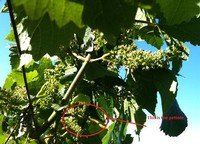 Things to think about when the vine is blooming.
Things to think about when the vine is blooming.
It’s a great time for assessing the vines nutrient status. We take plant tissue and send it to a A and L laboratory to analyze the concentration of different nutrients. The tissue we use is the petiole ( connects the leaf to the shoot). For standardizing the procedure we take the petiole located opposite the basal cluster. Tissue analysis at this time (60-70% cap fall) is great for giving you the vines micronutrient status. Whereas sampling at veraison is best for understanding your macro nutrient status.
Micronutrients:
Iron (Fe), Zinc (Zn), Copper (Cu), Manganese (Mn), Molybdenum (Mo), Boron (B), Aluminium (Al), Sodium (Na).
Common Micronutrient deficiencies in Oregon are Boron and Zinc. If there is a deficiency in a micronutrient it will be applied to the canopy in what’s called a “foliar application”.
Macronutrients:
Nitrogen (N), Potassium (K), Phosphorous (P), Sulfur (S), Calcium (Ca), Magnesium (Mg).
Macro-nutrients problems are best fixed through ground applications.
Other things to think about.
Botrytis! When the flower cap falls off it leaves a scar around the base of the ovary. If this scar isn’t protected there is potential that botrytis will infect the tissue. It will sit there until conditions are right for growth. This is called a latent infection.
Botrytis will also colonize any dead flowering tissue that is left in the cluster. Again it will sit there waiting for conditions to become right for further colonization/infvection. What can we do about this? We have to spray the flowers once 85% of the caps have fallen off.
This year in our organic sites we are trying two products Actinovate and Whey as a combination. Actinovate is a bacteria (Streptomyces) antagonist of botrytis and whey acts as a food source for the bacteria (Streptomyces). Trials performed in growers vineyards last year with the USDA showed that this was as effective as some of the synthetic products.
http://www.gwrdc.com.au/webdata/resources/files/BotrytisFactSheet.pdf
Time to harvest.
In Oregon it usually takes 100-110 days from bloom to harvest. If we call bloom today at the REX HILL home vineyard we will be harvesting some time between the 14th and 24th of October.
Who wants to guess the harvest date?
Growth and Cover Crops
- Bud break finished about 2 weeks ago and we are starting to see some leaves unfold and inflorescence becoming visible. Vineyards vary in phenology from 1 leaf separated through to 4 leaves separated.
- Development is slower than I would like due to the cool wet temperatures (La Nina pattern)
- We are seeing some minor mite damage causing Short Shoot Syndrome (SSS).
- Over winter the mites live in the bud scales and emerge at the same time as the shoots.
- They tend to feed on the growing shoots causing stunted, zig-zagging growth, scaring in the internodes and leaves distortion.
- The shoots will out grow the mite’s ability to keep the shoot stunted but to do that we need nice warm weather.
- Damage is generally sporadic
Figure 1.
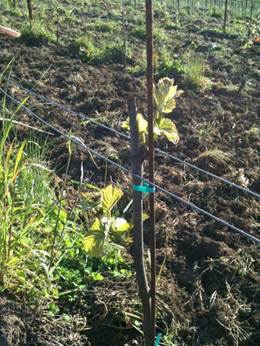
Figure 2. Short shoot syndrome
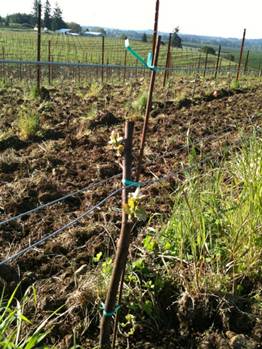
The two vines above were right next to each other in a young Pinot Noir block (4W) at Jacob Hart Vineyard. One showing strong healthy shoot growth and the other suffering from short shoot syndrome. We have treated this block with a light application of sulfur try and knock down the mite population. We will monitor the progress of effected vines and mite populations using double sided sticky tape wrapped around the trunk.
For those that are interested this website offers more information.
http://wine.oregonstate.edu/files/files/Short%20Shoot%20Symptoms%20of%20Grapes.pdf
Cover Crops
Fall cover crops
- We are now starting to work in our fall cover-crops of Winter Rye Grain and Vetch.
- These are planted in the rows that we cultivate to hold the soil in place over winter
- We also get the benefit of nitrogen fixation from the vetch
- Both these cover crops produce a great amount of biomass which is worked into the soil to increase organic matter content, soil life and quality.
- In the less vigorous areas we planted a combination of the two plants to increase soil fertility and possibly vigor (added nitrogen from the vetch)
- In the more vigorous areas we didn’t use vetch because we didn’t want the added nitrogen further increasing vigor.
Figure 3. Winter Rye grain planted in the Pinot Gris block at Jacob Hart.
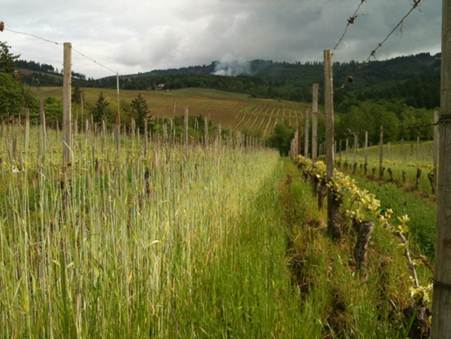
Spring Cover crops
- We have planted buckwheat and wildflowers at many of our sites: Jacob Hart, REX HILL, Pearl, Sims, Foley and Domain Margelle.
- We have planted these for their flowering qualities. These plants will provide nectar for a variety of insects and birds increasing the diversity of life within our vineyards.
- Why buckwheat? Once mature it will flower for a long period of time producing large quantities of nectar. Buckwheat has been shown to increase numbers of predatory beneficial insects and reduce pest populations to below economic thresholds.
Figure 4. Recently germinated buckwheat at REX HILL vineyard.
AVA’s: How many is too many?
He Said...
- Mike Willison
There are currently 199 American Viticultural Areas approved in the US by the TTB, with many more seemingly on the way. 112 of those AVA's are located in winemaking mega-state, California. This is enough until something significant changes. The US has the world's smallest and the world's largest appellations in the Cole Ranch, California AVA at 189 acres and the Upper Mississippi River Valley AVA at 19.1 million acres, respectively. While each state, hamlet and outcropping of rocks aims to distinguish itself by proving to the TTB that it, by virtue of its unique geographic and geological conditions, can make wines of identifiable distinction, three realities exist that preclude anyone from actually caring.
The first is the totally beat-into-the-ground by bloggers and wine geeks that is a totally true trend that most wine is not particularly different seeming than its neighbor geographically, varietally, or by virtue of shelf positioning at the bottle shop.
The second is that the historical precedent for appellations has been eroding into the ether for some time now. 300 years ago the world was very, very big. It was difficult for wine folk from the far reaches of the empire to communicate about methods, best practices and innovation which meant there was little corroboration between the winemakers of Alsace and Sicily, for example. Technique was passed down through generations and was collectively copied and tweaked within villages creating a sense of place that, in today's terms, was extremely small. The world, being very small now, has changed so that community includes us all, from the biggest wine barons to the smallest producer of closet blaufrankish, and we have the same tools, insights and technology available. Our village has become the world.
The third contributing factor is that many wine drinking people just don't care if their wine comes from San Ysidro or the Niagara Escarpment, just that it costs $X, depending on who they are trying to impress, if anyone.
If good wine tastes like it comes from somewhere and bad wine tastes like it comes from anywhere then we have been living in a pretty mediocre time for wine.
She Said...
- Carrie Kalscheuer
While I do think that there is some snobbery and certainly no shortage of marketing involved in the distinction of AVAs, I also think that the regional (and sub-regional) breakdown of winegrowing areas is a practice that can, and should, continue.
Wine regions are created to distinguish one region from the next, some based on soil type, some based on geography, some based on climate. While these may seem arbitrary to the average consumer, they are anything but to the winemakers and grape growers who exist within their confines.
The concept of terroir is alive and well in these debates. And we can't bring up this concept without allowing for its ambiguity. Given this, it doesn't make sense to argue that they are ill-defined or vague. By nature, of course they are.
When we start to ask smaller regions to distinguish themselves from one another without ANY ambiguity allowed, we may find it difficult to distinguish the large ones for truly solid reasons as well. It's a slippery slope. And with so much personal interest locked into the classifications of the different AVAs, attempting to place hard, factual, solid regulations upon a concept that is anything but is an impossible task. I say why try? Drink, enjoy, and be happy that people are taking enough pride in where they make wine to put their region on a map.
Phenological Stages
Viticulturists like to talk about phenology and phenological stages. Phenology is the study of the sequence of plant growth and investigates a plant’s reaction to the environment and attempts to predict its behavior in the new environment. A widely adopted system for recording grapevine phenology is the modified EL system. Below is a snapshot of the EL system.
Most Northern Willamette Valley vineyards are between stages 3 and 4. Lower altitude sites like REX HILL and Jacob Hart Vineyards are mostly stage 4. Historical average budbreak dates for the Willamette Valley are mid April. Why are we around two weeks behind? Because spring has been much cooler than normal due to the La Nina ocean currents in the Pacific Ocean.
Below are historical average monthly temperatures for the Portland area and what has been recorded this year, 2011.
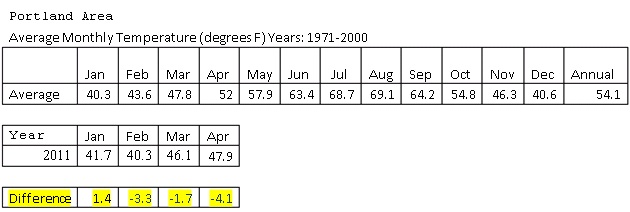
As you can see the months of February, March and April have been colder than average. April’s monthly average temperature was a chilly 4.1 degree F less than average and the predictions moving forward look similar. This is NOAA’s statement for May, June and July.
“THE TEMPERATURE OUTLOOK FOR MJJ 2011 IS, OVERALL, CONSISTENT WITH LA NINA CONDITIONS. PROBABILITIES OF BELOW NORMAL TEMPERATURES ARE ENHANCED FROM THE PACIFIC NORTHWEST EASTWARD ACROSS THE NORTHERN ROCKIES THROUGH THE GREAT LAKES REGION, INTO THE MIDDLE ATLANTIC COAST REGION. THE OCN PREDICTS PROBABILITES FOR ABOVE NORMAL TEMPERATURES ACROSS THE INTERIOR SOUTHWEST.
THE SEASONAL PRECIPITATION OUTLOOK FOR MJJ 2011 CALLS FOR GENERALLY ABOVE-MEDIAN PRECIPITATION IN NORTHERN SECTIONS OF THE CONUS. BELOW MEDIAN PRECIPITATION IS LIKELY ACROSS THE SOUTH-CENTRAL U.S. AND IN PARTICULAR, TEXAS AND LOUISIANA. IN SPITE OF THE EXPECTED WEAKENING OF LA NINA TO NEUTRAL STATUS BY JUNE 2011, THE ABNORMALLY WET SOILS IN NORTHERN SECTIONS OF THE CONTIGUOUS UNITED STATES, AND ABNORMALLY DRY SOILS IN THE SOUTH, ARE LIKELY TO LEAD TO A CONTINUATION OF COOL, WET CONDITIONS IN THE NORTH AND WARM DRY CONDITIONS IN THE SOUTH. “ http://www.cpc.ncep.noaa.gov/products/predictions/90day/seasglossary.html#la%20nina
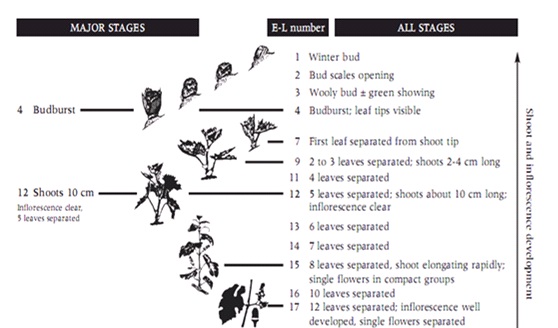
Recent Posts
-
October 12, 2018
-
June 7, 2018
-
October 30, 2017
-
October 23, 2017
-
September 13, 2017
-
April 17, 2017
-
July 21, 2016
-
June 2, 2016
-
May 25, 2016
-
May 18, 2016
Blog Categories
Blog Archives
Our Writers
- Leanne Bellncula (2)
- Shelli Brinson Fowler (1)
- Tom Caruso (2)
- Ryan Collins (20)
- Bill Hatcher (10)
- Deb Hatcher (2)
- REX HILL (59)
- Kelly Irelan (1)
- Carrie Kalscheuer (3)
- Jonathan Lampe (3)
- Karina Lopez (1)
- Meredith McGough (1)
- Katie McLennan (2)
- Charlotte Mischel (2)
- Karen Peterson (2)
- Olivier Prost (2)
- Tom Reed (1)
- Emily Sadler (1)
- Sam Tannahill (2)
- Mike Willison (4)


